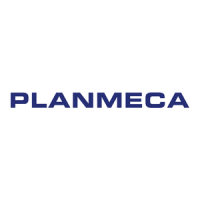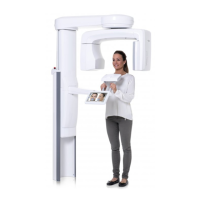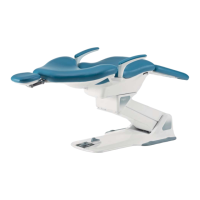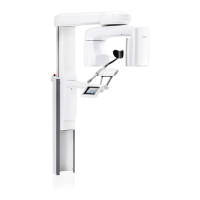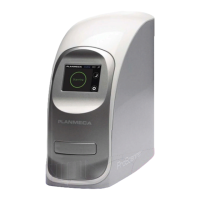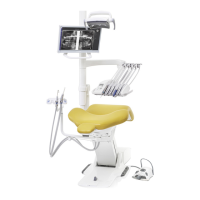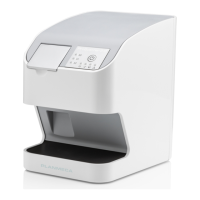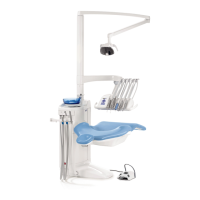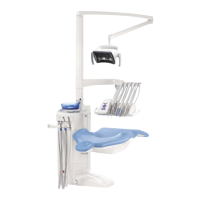Do you have a question about the Planmeca Sovereign Classic and is the answer not in the manual?
Explains standard packaging symbols like 'this side up', 'fragile', and temperature/humidity limits.
Details critical warnings and precautions for safe operation and maintenance of the dental unit.
Describes safety switches that stop motorized movements due to obstructions.
Explains sensors that restrict or disable chair movements when parts are not in their home position.
Details the two main configurations: over-the-patient delivery with balanced or hanging instruments.
Lists and illustrates detachable components not critical to operation.
Identifies parts that come into contact with the patient during normal treatment.
Provides instructions and cautions related to the dental unit's bowl.
Describes the monitor's movability and safety precautions during use.
Explains how to attach a tablet to the Flexy-holder.
Details the dental unit's two USB ports and their functionalities.
Explains how to manually swivel the dental unit and its movement limits.
Locates and describes the water and air quick-connectors and tray attachment.
Explains the necessity of connecting to Planmeca Romexis for specific features.
Details the mounting of the Planmeca ProX X-ray unit to the dental unit.
Describes how to connect and place the intraoral scanner in the Flexy-holder.
Explains the mounting of the Zeiss OPMI pico microscope to the dental unit.
Describes the OP delivery arm attachment and positioning.
Details the instrument console, including balanced and hanging-tube instrument options.
Explains the connection and use of quick-connector hoses for instruments.
Lists the instruments compatible with the dental unit console.
Describes tray tables for both balanced-arm and hanging-tube instrument consoles.
Covers the setup and use of the sterile water system for instruments.
Explains the Flexy-holder's role in housing suction handpieces and control panels.
Provides steps for safely removing and replacing suction tubes for hygiene.
Introduces the integrated patient chair, its design, and ergonomic benefits.
Explains the sensor-based patient recognition system and its display icons.
Details the automatic legrest, its folding capability, and synchronization with the backrest.
Describes the Trendelenburg position for patient collapsing events.
Explains how to manually swivel the patient chair and release the lock.
Describes the movement and locking mechanism of the armrests.
Covers manual adjustments for headrest height, angle, and child/short patient positioning.
Identifies the main control panel on the instrument console and the one on the Flexy-holder.
Details the instrument console's touch display for unit and instrument control.
Explains the Flexy-holder control panel for unit and chair operations.
Introduces the integrated foot control, available in wireless and standard versions.
Describes the standard and wide foot control pedals and their differences.
Explains how to view and program foot control functions for instruments.
Details the programmable functions assigned to the center knob.
Lists possible functions for side knobs based on the activated instrument.
Details programmable functions assigned to the pedal.
Describes the default functions for side knobs and pedals.
Provides notes on the optional wireless foot control's features and operation.
Explains methods for signing in, including PlanID card, user list, and guest user.
Details how to sign out, save settings, and handle automatic sign-out.
Explains personal settings and their storage location (unit/Romexis).
Step-by-step guide for creating a new user profile in the Sign in window.
Provides instructions on how to delete a user profile from the dental unit.
Guides on editing user-specific settings like name, language, and color theme.
Explains how to transfer settings between the dental unit, USB, and Planmeca Romexis.
Details how to reset personal settings to factory defaults.
Describes how to access technical details and software information about the unit.
Information on identifying the unit type and its serial number.
Details on how to view the unit's software version and related information.
Provides access to service contact details, maintenance schedules, and storage information.
Explains GUI diagnostics for control panel hardware and error finding.
Covers dental unit IP address, Romexis, and Solanna Vision network settings.
Explains how to view help and error messages recorded by the dental unit.
Details Bluetooth connection management and viewing software licences.
Provides detailed steps for manual operation of chair movements.
Explains how to store, select, and manage automatic chair positions.
Describes the specialist mode for slower, controlled chair movements.
Details how to activate and control the bowl rinse function.
Explains automatic and manual cup fill operations.
Guides on using the dental unit's timer for pre-programmed time settings.
Describes how to enable and operate the door open function.
Explains how to enable and use the assistant call feature.
Covers operation, indicator lights, gesture sensor, and switching.
Details camera activation, settings adjustment, video streaming, and recording.
Explains the optional water and air quick-connector system.
Describes using the control panel display as an X-ray film viewer.
Explains the unit's instrument logic for active/inactive instruments and four-handed dentistry.
Covers micromotor presets, handpiece selection, speed/power, and torque settings.
Details the use of the Apex locator, including setup, testing, and operation.
Explains turbine speed/power, quickstart, speed limits, spray, chip blow, and instrument light.
Covers scaler speed/power, spray settings, and modes for different scaler types.
Describes the polymerisation light's operation, programming, and independent mode.
Details the use of intraoral cameras with Planmeca Romexis software.
Explains the operation of the intraoral scanner, especially from the foot control.
Describes the automatic start/stop and manual control of suction handpieces.
Explains the tilting mechanism for starting and stopping suction.
Explains the general pattern and notes for programming dental unit settings.
Guides on customizing the swipe menu on the control panel.
Details how to program and manage automatic chair positions.
Explains how to program chair movement speed for specialist mode.
Covers programming for instrument speed/power, quickstart, spray, chip blow, and light.
Guides on programming up to six timer settings into the timer memory.
Explains how to adjust flow rates for bowl rinse and cup fill.
Details programming for light intensity, color temperature, and gesture sensor.
Explains how to program and adjust the door open and assistant call functions.
Guides on setting the clock and date, including 12/24 hour format.
Explains how to enable and adjust duration for water and air quick-connectors.
Details how to enable/disable the bottle water mode.
Guides on programming functions to the Flexy button.
Explains programming for single-push and short/long push modes for foot controls.
Covers pairing wireless foot controls and adjusting radio settings.
Instructions for filling the water container with clean water or disinfectant.
Details on filling PlanClear and suction disinfectant containers.
Provides a table outlining recommended intervals for various cleaning programs.
General notes and cautions regarding flushing and cleaning procedures.
Explains how to view and modify the dental unit's maintenance protocol.
Describes scheduling and initiating cleaning programs remotely via Planmeca Romexis.
Instructions for testing water quality after waterline cleaning.
Details the procedures for short and long flushing cycles.
Explains the procedure for suction flushing.
Provides steps for cleaning the suction system and handpieces.
Covers continuous and periodical waterline cleaning approaches.
Details the procedure for performing an extensive flushing cycle.
Lists approved disinfectants and general cleaning guidelines.
Table detailing daily, weekly, and monthly cleaning schedules for unit surfaces.
Instructions for cleaning and servicing instruments.
Covers maintenance of the instrument console, including the oil collector.
Details cleaning procedures for the bowl and water container.
Instructions for cleaning the instrument flushing holder.
Guidance on emptying and replacing coarse filters.
Procedures for cleaning the suction tube cleaning holder and separation tank.
Covers morning, after-patient, and after-working-day cleaning of the suction system.
Information on cleaning the Planmeca intraoral scanner.
Guidelines for cleaning the external PC, mouse, and keyboard.
Reference to manufacturer's documentation for cleaning the Zeiss OPMI pico.
Explains the three types of messages: notifications, help, and error messages.
A list of help messages with their codes, meanings, and actions.
Categorized error codes for general, instrument, chair, and water systems.
Instructions on how to view the log of help and error messages.
Lists suction handpieces with order numbers and materials.
Details the part number and material for sterile water hoses.
Lists infection control parts with order numbers and materials.
Lists disinfectants and test strips with their order numbers.
Provides details on manufacturer, colors, dimensions, weight, and loads.
Details patient, dentist, assistant positioning and space requirements.
Illustrates side view dimensions and optimal space requirements.
Illustrates top view dimensions and unit turning radii.
Provides dimensions for adaptive and automatic legrests.
Declares compliance of PlanID™ radio equipment with EU directives.
Declares conformity of PlanID RFID-reader with EU directives.
FCC compliance notice for the wireless foot control regarding interference.
FCC compliance notice for the PlanID RFID-reader regarding interference.
Industry Canada compliance statement for license-exempt RSS standards.
French Industry Canada compliance statement for license-exempt RSS standards.
States FCC RF exposure limits compliance for portable configuration.
Explains standard packaging symbols like 'this side up', 'fragile', and temperature/humidity limits.
Details critical warnings and precautions for safe operation and maintenance of the dental unit.
Describes safety switches that stop motorized movements due to obstructions.
Explains sensors that restrict or disable chair movements when parts are not in their home position.
Details the two main configurations: over-the-patient delivery with balanced or hanging instruments.
Lists and illustrates detachable components not critical to operation.
Identifies parts that come into contact with the patient during normal treatment.
Provides instructions and cautions related to the dental unit's bowl.
Describes the monitor's movability and safety precautions during use.
Explains how to attach a tablet to the Flexy-holder.
Details the dental unit's two USB ports and their functionalities.
Explains how to manually swivel the dental unit and its movement limits.
Locates and describes the water and air quick-connectors and tray attachment.
Explains the necessity of connecting to Planmeca Romexis for specific features.
Details the mounting of the Planmeca ProX X-ray unit to the dental unit.
Describes how to connect and place the intraoral scanner in the Flexy-holder.
Explains the mounting of the Zeiss OPMI pico microscope to the dental unit.
Describes the OP delivery arm attachment and positioning.
Details the instrument console, including balanced and hanging-tube instrument options.
Explains the connection and use of quick-connector hoses for instruments.
Lists the instruments compatible with the dental unit console.
Describes tray tables for both balanced-arm and hanging-tube instrument consoles.
Covers the setup and use of the sterile water system for instruments.
Explains the Flexy-holder's role in housing suction handpieces and control panels.
Provides steps for safely removing and replacing suction tubes for hygiene.
Introduces the integrated patient chair, its design, and ergonomic benefits.
Explains the sensor-based patient recognition system and its display icons.
Details the automatic legrest, its folding capability, and synchronization with the backrest.
Describes the Trendelenburg position for patient collapsing events.
Explains how to manually swivel the patient chair and release the lock.
Describes the movement and locking mechanism of the armrests.
Covers manual adjustments for headrest height, angle, and child/short patient positioning.
Identifies the main control panel on the instrument console and the one on the Flexy-holder.
Details the instrument console's touch display for unit and instrument control.
Explains the Flexy-holder control panel for unit and chair operations.
Introduces the integrated foot control, available in wireless and standard versions.
Describes the standard and wide foot control pedals and their differences.
Explains how to view and program foot control functions for instruments.
Details the programmable functions assigned to the center knob.
Lists possible functions for side knobs based on the activated instrument.
Details programmable functions assigned to the pedal.
Describes the default functions for side knobs and pedals.
Provides notes on the optional wireless foot control's features and operation.
Explains methods for signing in, including PlanID card, user list, and guest user.
Details how to sign out, save settings, and handle automatic sign-out.
Explains personal settings and their storage location (unit/Romexis).
Step-by-step guide for creating a new user profile in the Sign in window.
Provides instructions on how to delete a user profile from the dental unit.
Guides on editing user-specific settings like name, language, and color theme.
Explains how to transfer settings between the dental unit, USB, and Planmeca Romexis.
Details how to reset personal settings to factory defaults.
Describes how to access technical details and software information about the unit.
Information on identifying the unit type and its serial number.
Details on how to view the unit's software version and related information.
Provides access to service contact details, maintenance schedules, and storage information.
Explains GUI diagnostics for control panel hardware and error finding.
Covers dental unit IP address, Romexis, and Solanna Vision network settings.
Explains how to view help and error messages recorded by the dental unit.
Details Bluetooth connection management and viewing software licences.
Provides detailed steps for manual operation of chair movements.
Explains how to store, select, and manage automatic chair positions.
Describes the specialist mode for slower, controlled chair movements.
Details how to activate and control the bowl rinse function.
Explains automatic and manual cup fill operations.
Guides on using the dental unit's timer for pre-programmed time settings.
Describes how to enable and operate the door open function.
Explains how to enable and use the assistant call feature.
Covers operation, indicator lights, gesture sensor, and switching.
Details camera activation, settings adjustment, video streaming, and recording.
Explains the optional water and air quick-connector system.
Describes using the control panel display as an X-ray film viewer.
Explains the unit's instrument logic for active/inactive instruments and four-handed dentistry.
Covers micromotor presets, handpiece selection, speed/power, and torque settings.
Details the use of the Apex locator, including setup, testing, and operation.
Explains turbine speed/power, quickstart, speed limits, spray, chip blow, and instrument light.
Covers scaler speed/power, spray settings, and modes for different scaler types.
Describes the polymerisation light's operation, programming, and independent mode.
Details the use of intraoral cameras with Planmeca Romexis software.
Explains the operation of the intraoral scanner, especially from the foot control.
Describes the automatic start/stop and manual control of suction handpieces.
Explains the tilting mechanism for starting and stopping suction.
Explains the general pattern and notes for programming dental unit settings.
Guides on customizing the swipe menu on the control panel.
Details how to program and manage automatic chair positions.
Explains how to program chair movement speed for specialist mode.
Covers programming for instrument speed/power, quickstart, spray, chip blow, and light.
Guides on programming up to six timer settings into the timer memory.
Explains how to adjust flow rates for bowl rinse and cup fill.
Details programming for light intensity, color temperature, and gesture sensor.
Explains how to program and adjust the door open and assistant call functions.
Guides on setting the clock and date, including 12/24 hour format.
Explains how to enable and adjust duration for water and air quick-connectors.
Details how to enable/disable the bottle water mode.
Guides on programming functions to the Flexy button.
Explains programming for single-push and short/long push modes for foot controls.
Covers pairing wireless foot controls and adjusting radio settings.
Instructions for filling the water container with clean water or disinfectant.
Details on filling PlanClear and suction disinfectant containers.
Provides a table outlining recommended intervals for various cleaning programs.
General notes and cautions regarding flushing and cleaning procedures.
Explains how to view and modify the dental unit's maintenance protocol.
Describes scheduling and initiating cleaning programs remotely via Planmeca Romexis.
Instructions for testing water quality after waterline cleaning.
Details the procedures for short and long flushing cycles.
Explains the procedure for suction flushing.
Provides steps for cleaning the suction system and handpieces.
Covers continuous and periodical waterline cleaning approaches.
Details the procedure for performing an extensive flushing cycle.
Lists approved disinfectants and general cleaning guidelines.
Table detailing daily, weekly, and monthly cleaning schedules for unit surfaces.
Instructions for cleaning and servicing instruments.
Covers maintenance of the instrument console, including the oil collector.
Details cleaning procedures for the bowl and water container.
Instructions for cleaning the instrument flushing holder.
Guidance on emptying and replacing coarse filters.
Procedures for cleaning the suction tube cleaning holder and separation tank.
Covers morning, after-patient, and after-working-day cleaning of the suction system.
Information on cleaning the Planmeca intraoral scanner.
Guidelines for cleaning the external PC, mouse, and keyboard.
Reference to manufacturer's documentation for cleaning the Zeiss OPMI pico.
Explains the three types of messages: notifications, help, and error messages.
A list of help messages with their codes, meanings, and actions.
Categorized error codes for general, instrument, chair, and water systems.
Instructions on how to view the log of help and error messages.
Lists suction handpieces with order numbers and materials.
Details the part number and material for sterile water hoses.
Lists infection control parts with order numbers and materials.
Lists disinfectants and test strips with their order numbers.
Provides details on manufacturer, colors, dimensions, weight, and loads.
Details patient, dentist, assistant positioning and space requirements.
Illustrates side view dimensions and optimal space requirements.
Illustrates top view dimensions and unit turning radii.
Provides dimensions for adaptive and automatic legrests.
Declares compliance of PlanID™ radio equipment with EU directives.
Declares conformity of PlanID RFID-reader with EU directives.
FCC compliance notice for the wireless foot control regarding interference.
FCC compliance notice for the PlanID RFID-reader regarding interference.
Industry Canada compliance statement for license-exempt RSS standards.
French Industry Canada compliance statement for license-exempt RSS standards.
States FCC RF exposure limits compliance for portable configuration.
| Brand | Planmeca |
|---|---|
| Model | Sovereign Classic |
| Category | Dental equipment |
| Language | English |
